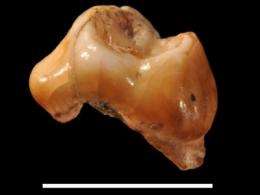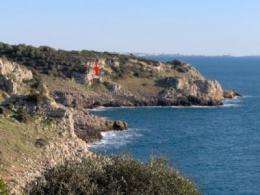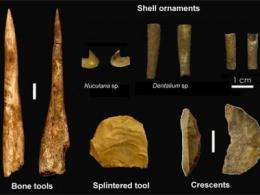Homo sapiens arrived in Europe earlier than previously believed

Members of our species (Homo sapiens) arrived in Europe several millennia earlier than previously thought. At this conclusion a team of researchers, led by the Department of Anthropology, University of Vienna, arrived after re-analyses of two ancient deciduous teeth. These teeth were discovered 1964 in the "Grotta del Cavallo", a prehistoric cave in southern Italy. Since their discovery they have been attributed to Neanderthals, but this new study suggests they belong to anatomically modern humans. Chronometric analysis, carried out by the Oxford Radiocarbon Accelerator Unit at the University of Oxford, shows that the layers within which the teeth were found date to ~43,000-45,000 cal BP. This means that the human remains are older than any other known European modern humans. The research work was published in the renowned science journal Nature.
Grotta del Cavallo, in Apulia, was discovered in 1960. It contained about 7 m of archaeological deposits spanning the period during which Neanderthals were replaced by modern humans. Two milk teeth were unearthed in 1964 by Arturo Palma di Cesnola (emeritus of the University of Siena) from the so-called Uluzzian archaeological layers. The Uluzzian culture has been described from more than 20 separate sites across Italy, and is characterised by personal ornaments, bone tools and colourants; items typically associated with modern human symbolic behaviour. But the teeth from Cavallo were identified in the 1960's as Neanderthals who lived around 200,000 to 40,000 years ago. This attribution has been at the heart of a widely held consensus that the Uluzzian and the complex ornaments and tools within it were also produced by Neanderthals.

Stefano Benazzi, post-doc at the Department of Anthropology at University of Vienna, and his colleagues were able to compare digital models derived from micro-computed tomography scans of the human remains from Grotta del Cavallo with those of a large modern human and Neanderthal dental sample: "We worked with two independent methods: for the one, we measured the thickness of the tooth enamel, and for the other, the general outline of the crown. By means of micro-computed tomography it was possible to compare the internal and external features of the dental crown. The results clearly show that the specimens from Grotta del Cavallo were modern humans, not Neanderthals as originally thought."
Katerina Douka, post-doc at the Research Laboratory for Archaeology and History of Art at the University of Oxford, undertook a comprehensive programme of radiocarbon dating to establish a firm chronology for the finds. Previous dates for the Uluzzian were problematic and affected by contamination. Since the teeth were too small to date directly, Douka developed a new approach that focused on the dating of marine shells found in the same archaeological levels as the teeth. This approach showed that the modern human teeth must date to between ~43,000-45,000 years ago. Douka said, "Radiocarbon dating of Palaeolithic material is difficult because the levels of remaining radiocarbon are very low and contamination can be problematic. Shell beads are important objects of body ornamentation and have allowed us directly and reliably radiocarbon date items associated with these early Homo sapiens settlers of Europe."

"What the new dates mean", Benazzi summarised, "is that these two teeth from Grotta del Cavallo represent the oldest European modern human fossils currently known. This find confirms that the arrival of our species on the continent – and thus the period of coexistence with Neanderthals – was several thousand years longer than previously thought. Based on this fossil evidence, we have confirmed that modern humans and not Neanderthals are the makers of the Uluzzian culture. This has important implications to our understanding of the development of 'fully modern' human behaviour. Whether the colonisation of the continent occurred in one or more waves of expansion and which routes were followed is still to be established."
More information: The Early dispersal of modern humans in Europe and implications for Neanderthal behaviour. Benazzi, S., Douka, K., Fornai, C., Bauer, C.C., Kullmer, O., Svoboda, J., Pap, I., Mallegni, F., Bayle, P., Coquerelle, M., Condemi, S., Ronchitelli, A., Harvati, K., Weber, G.W. In. Nature, Nov. 3, 2011. DOI 10.1038/nature10617
Provided by University of Vienna




















